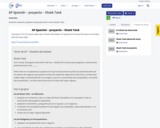
Formative Assessment - Investigate and analyze function families - Just in Time Quick Check, Teacher Notes, and Supporting Resources
- Subject:
- Mathematics
- Material Type:
- Assessment
- Lesson Plan
- Provider:
- VDOE
- Author:
- VDOE
- Date Added:
- 10/07/2024

Formative Assessment - Investigate and analyze function families - Just in Time Quick Check, Teacher Notes, and Supporting Resources

Formative Assessment - Investigate and analyze function families - Just in Time Quick Check, Teacher Notes, and Supporting Resources

Formative Assessment - Investigate and analyze function families - Just in Time Quick Check, Teacher Notes, and Supporting Resources

Formative Assessment - Investigate and analyze function families - Just in Time Quick Check, Teacher Notes, and Supporting Resources

Formative Assessment - Investigate and analyze function families - Just in Time Quick Check, Teacher Notes, and Supporting Resources

Formative Assessment - Investigate and analyze linear, quadratic, absolute value, square root, cube root, rational, polynomial, exponential, and logarithmic function families - Just in Time Quick Check, Teacher Notes, and Supporting Resources

Formative Assessment - Investigate and analyze function families - Just in Time Quick Check, Teacher Notes, and Supporting Resources

Formative Assessment - Investigate and analyze function families; Connections between multiple representations of functions - Just in Time Quick Check, Teacher Notes, and Supporting Resources

Formative Assessment - Investigate and analyze function families; Focus on end behavior - Just in Time Quick Check, Teacher Notes, and Supporting Resources

Formative Assessment - Investigate and analyze function families; Focus on vertical and horizontal asymptotes - Just in Time Quick Check, Teacher Notes, and Supporting Resources

Formative Assessment - Investigate and analyze function families; Focus on inverse of a function - Just in Time Quick Check, Teacher Notes, and Supporting Resources

Formative Assessment - Investigate and analyze function families; Focus on composition of functions algebraically and graphically - Just in Time Quick Check, Teacher Notes, and Supporting Resources

Exploring relationships among factors, zeros, and solutions - Mathematics Instructional Plan

Formative Assessment - Investigate and describe the relationships among solutions of an equation, zeros of a function, x-intercepts of a graph, and factors of a polynomial expression - Just in Time Quick Check, Teacher Notes, and Supporting Resources

Formative Assessment - Collect and analyze data, determine the equation of the curve of best fit in order to make predictions and solve practical problems, using mathematical models of quadratic and exponential functions - Just in Time Quick Check, Teacher Notes, and Supporting Resources

Challenges students to think outside of the box to find examples of government around their school campus. All areas of the curriculum are covered and students have to defend their answer.

Students research, prepare and present the tv show Shark Tank.

Your friend asked you to enter a texting/typing competition but have months to practice. We know practicing something makes you better at it. You will be given your current speed and how well you improve over each month. It is your job to find your texting/typing speed given a number of months that you have practiced. You are also to look over other student’s work to see if they made an error and if so, where.

This performance task is designed for third grade and up to teach the importance of using strong passwords. This would be helpful to use at the beginning of the year to review password safety with upper elementary school students to refresh their memory. This includes an instructional slide show and a student handout.

This is an activity that can be used to introduce students to how the ASCII code is used in representing letters in coding. Students will be given a table of the ASCII code that will be used to decode words and phases. Then students will create a message in ASCII code and exchange with a fellow student to decyper the code. An extension of this lesson can be to intoduce students to binary code that represent each digit int he ASCII code.